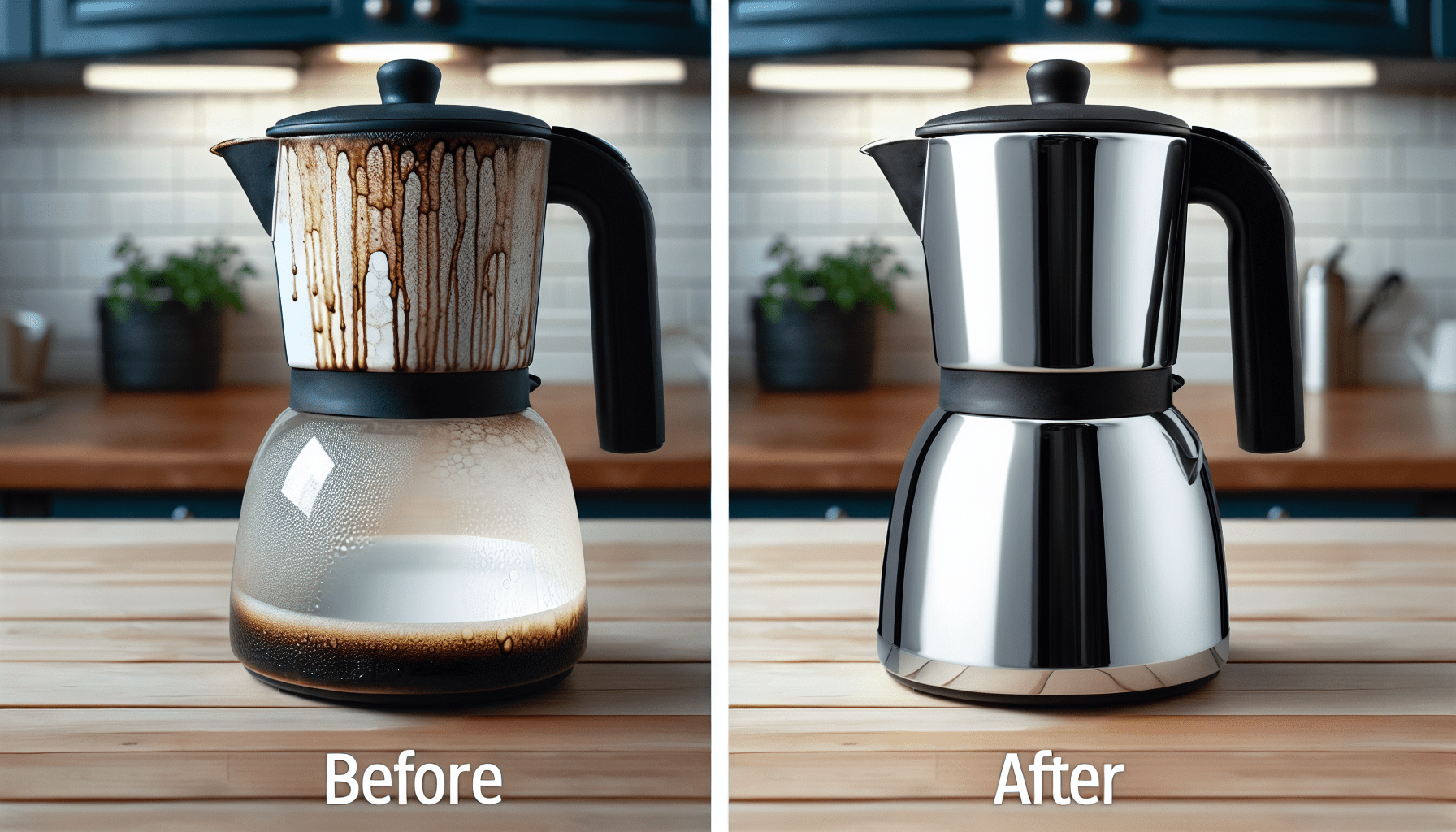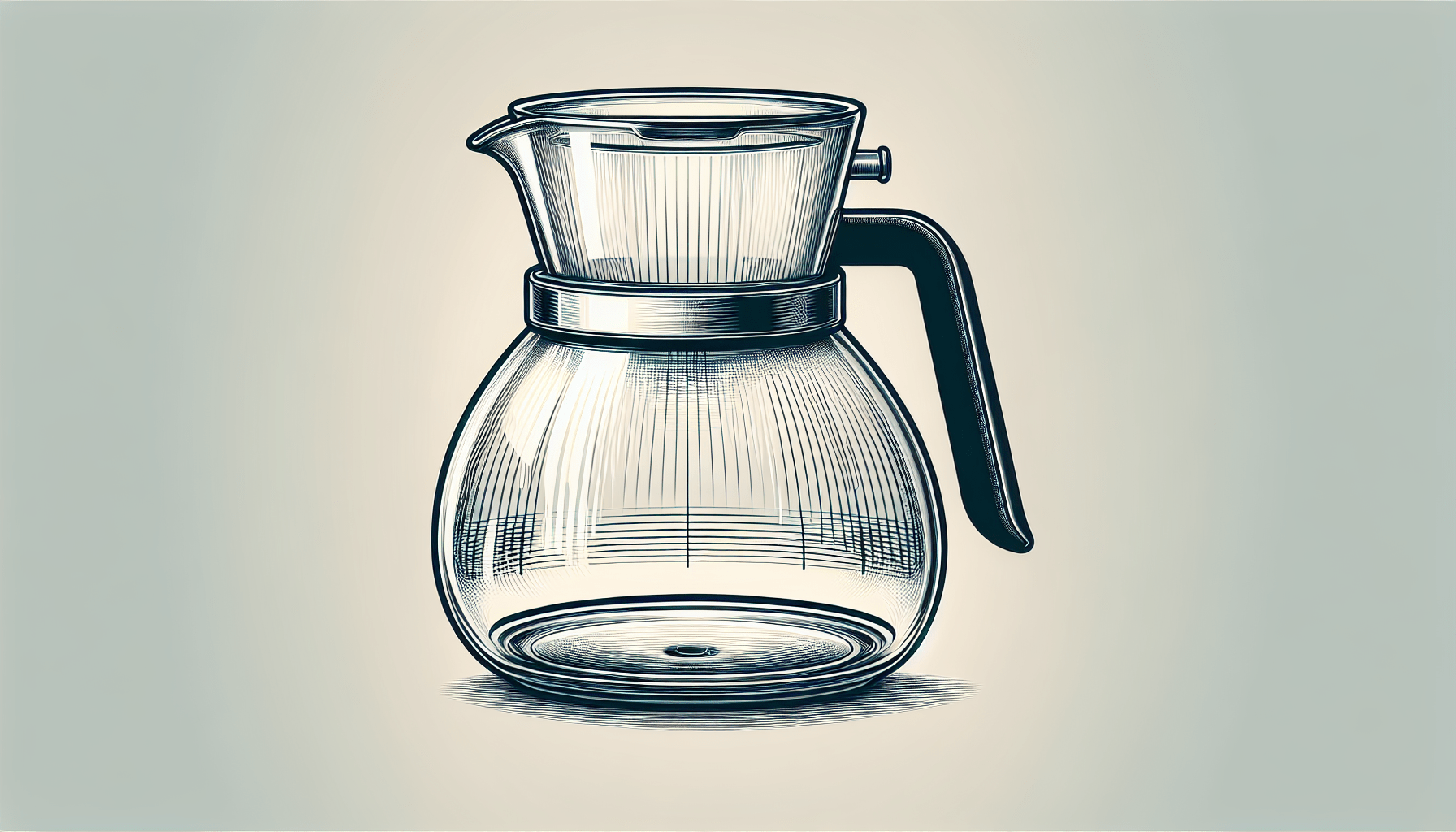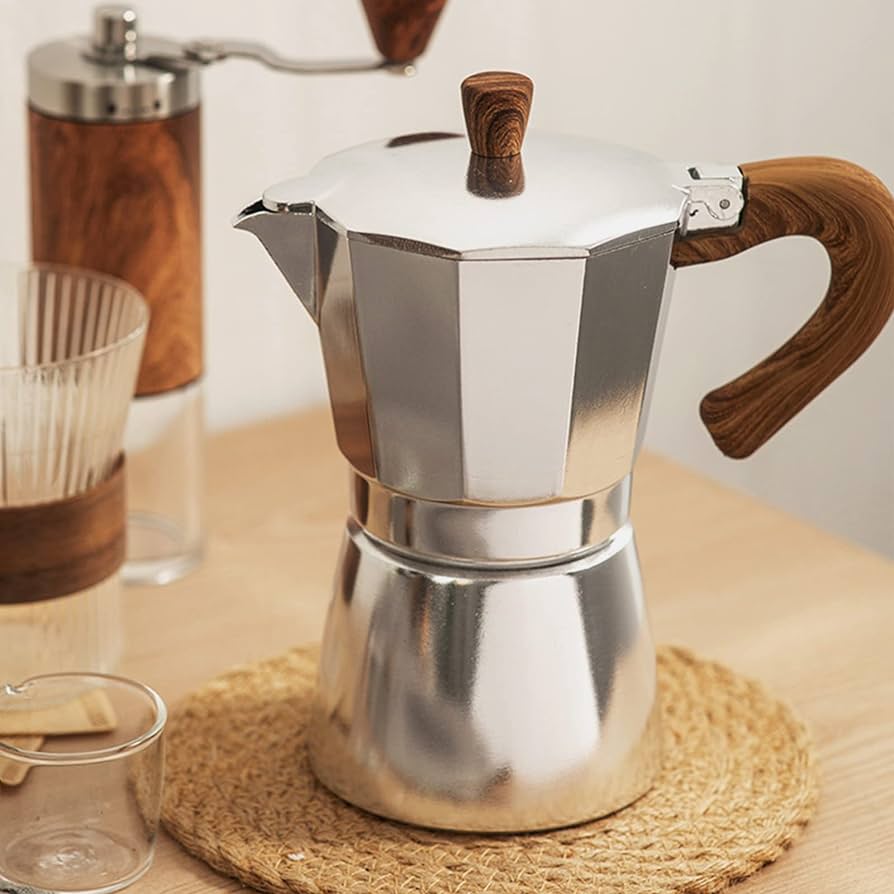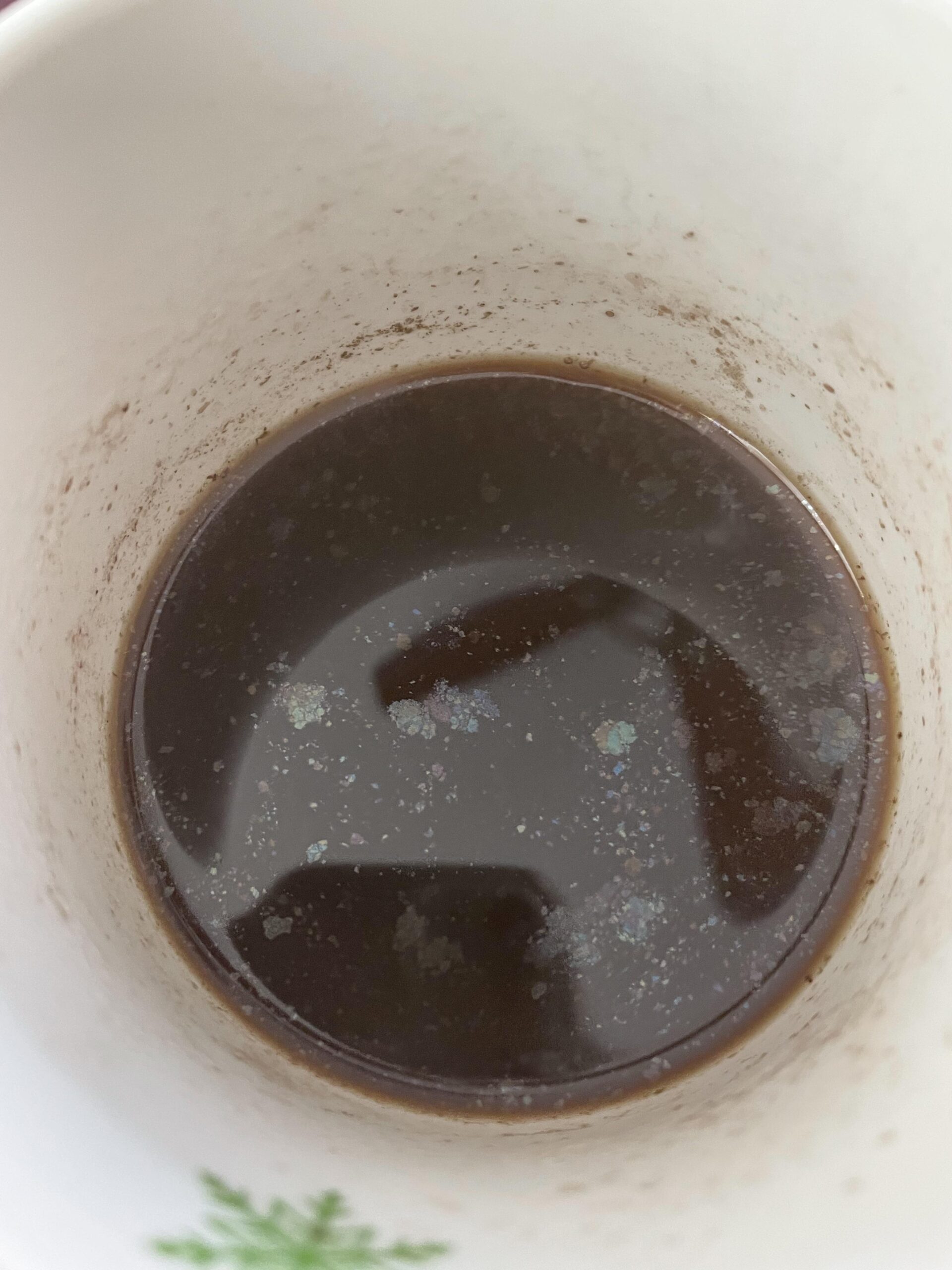Are you tired of seeing that stubborn burnt coffee residue in your coffee maker pot? Don’t worry, we have got you covered! In this article, we will explore some effective and easy ways to remove that pesky residue and get your coffee maker pot looking brand new again. Whether you have a glass or stainless steel pot, these simple techniques will help you say goodbye to those unsightly stains and enjoy a fresh cup of coffee every time.
Using Vinegar Solution
Mixing the vinegar solution
If you’re dealing with a burnt coffee residue in your coffee maker pot, one effective solution is to use a vinegar solution. Vinegar has natural cleaning properties that can help break down the stubborn stains and residue left behind. To make the vinegar solution, simply mix equal parts of vinegar and water in a bowl or container. You can use either white vinegar or apple cider vinegar, depending on your preference.
Pouring the vinegar solution into the pot
Once you have prepared the vinegar solution, carefully pour it into the coffee maker pot. Make sure to cover the entire surface area affected by the burnt residue. The acidity in the vinegar will help to dissolve and loosen the stubborn stains.
Allowing the solution to sit
After pouring the vinegar solution into the pot, it’s important to allow it to sit for a while. The vinegar needs time to work its magic and break down the burnt coffee residue. Depending on the severity of the stains, you can let the solution sit for anywhere between 30 minutes to several hours. Patience is key when it comes to removing stubborn stains.
Scrubbing the pot with a brush
Once the vinegar solution has had enough time to sit, it’s time to start scrubbing the pot. Use a non-abrasive brush or sponge to gently scrub the surface of the pot. The abrasive nature of the brush will help to loosen the residue and make it easier to remove. Be sure to scrub all the nooks and crannies, including the interior walls and the bottom of the pot.
Rinsing the pot thoroughly
After you have finished scrubbing the pot, it’s crucial to rinse it thoroughly to remove any leftover residue and vinegar solution. Rinse the pot with warm water, making sure to remove all traces of the vinegar. You may need to rinse and repeat this step a few times to ensure that the pot is completely clean. Once rinsed, allow the pot to air dry or gently wipe it dry with a clean cloth.
Using Baking Soda
Creating a baking soda paste
Baking soda is another effective household ingredient that can help remove burnt coffee residue from your coffee maker pot. To create a baking soda paste, mix baking soda with a small amount of water until you achieve a thick, spreadable consistency. The ratio of baking soda to water may vary depending on the size of your pot, but start with a 1:1 ratio and adjust as needed.
Applying the paste to the pot
Once you have created the baking soda paste, apply it to the interior surface of the coffee maker pot. Use a non-abrasive brush or sponge to spread the paste evenly, making sure to cover all areas affected by the burnt residue. The baking soda will act as a gentle abrasive, helping to remove the stains without scratching the pot.
Scrubbing the pot with the paste
After applying the baking soda paste, it’s time to start scrubbing the pot. Use the brush or sponge to gently scrub the surface, focusing on the areas with the most stubborn residue. The texture of the baking soda will help to lift the stains and break down the burnt coffee residue. Take your time and be thorough to ensure that all the stains are effectively treated.
Rinsing the pot thoroughly
Once you have finished scrubbing the pot with the baking soda paste, rinse it thoroughly with warm water. Make sure to remove all traces of the baking soda paste and burnt residue. You may need to repeat the rinsing step a few times to ensure a clean pot. After rinsing, allow the pot to air dry or gently wipe it dry with a clean cloth.
Using Lemon Juice
Squeezing fresh lemon juice
Lemon juice is known for its natural cleaning properties and pleasant citrus scent. To utilize lemon juice for removing burnt coffee residue, start by squeezing fresh lemon juice from one or two lemons. The acidity in the lemon juice will help to break down the stains and leave your coffee maker pot smelling fresh.
Heating the lemon juice
Before using the lemon juice, it’s recommended to heat it up slightly. You can do this by microwaving the lemon juice in a microwave-safe container for a short period of time. Alternatively, you can heat the lemon juice on the stovetop in a small saucepan. The heat will enhance the cleaning power of the lemon juice and make it more effective in removing burnt residue.
Pouring the hot lemon juice into the pot
Once the lemon juice is heated, carefully pour it into the coffee maker pot. Make sure to cover the entire surface area affected by the burnt residue. The hot lemon juice will penetrate the stains and help to loosen them, making them easier to remove.
Allowing the juice to sit
After pouring the hot lemon juice into the pot, it’s important to allow it to sit for a while. The heat and acidity of the lemon juice will work together to break down and dissolve the burnt coffee residue. Depending on the severity of the stains, you can let the lemon juice sit for 30 minutes to an hour.
Scrubbing the pot with a brush
Once the lemon juice has had enough time to work its magic, use a non-abrasive brush or sponge to scrub the pot. The brush will help to loosen the stains further and aid in their removal. Focus on the areas with the most stubborn residue, and be thorough in your scrubbing.
Rinsing the pot thoroughly
After scrubbing the pot with the lemon juice, rinse it thoroughly with warm water. Make sure to remove all traces of the lemon juice and burnt residue. You may need to rinse and repeat this step a few times to ensure a clean and residue-free pot. After rinsing, allow the pot to air dry or gently wipe it dry with a clean cloth.
Using Dish Soap
Filling the pot with hot water
If you prefer a milder cleaning method, dish soap can be an effective option for removing burnt coffee residue. Start by filling the coffee maker pot with hot water. The hot water will help to dissolve the residue and make it easier to clean.
Adding a few drops of dish soap
Once the pot is filled with hot water, add a few drops of dish soap. The dish soap will help to break down the oils and stains left behind by the burnt coffee. Use a mild dish soap that does not contain harsh chemicals or fragrances.
Letting the pot soak
After adding the dish soap, let the pot soak for some time. The soaking process will allow the dish soap to penetrate the burnt residue and loosen it. Depending on the severity of the stains, you can let the pot soak for 30 minutes to an hour.
Scrubbing the pot with a brush
After the soaking period, use a non-abrasive brush or sponge to scrub the pot. The brush will help to further loosen the residue and aid in its removal. Be thorough in your scrubbing, paying attention to all areas of the pot.
Rinsing the pot thoroughly
Once you have finished scrubbing, rinse the pot thoroughly with warm water. Make sure to remove all traces of the dish soap and burnt residue. You may need to rinse and repeat this step a few times to ensure a clean pot. After rinsing, allow the pot to air dry or gently wipe it dry with a clean cloth.
Using Denture Tablets
Dissolving denture tablets in hot water
Denture tablets are not only great for cleaning dentures but can also be highly effective in removing burnt coffee residue from a coffee maker pot. Start by dissolving a few denture tablets in hot water. The effervescence and cleaning agents in the tablets will help to break down the stains and residue.
Pouring the solution into the pot
Once the denture tablets are fully dissolved in hot water, carefully pour the solution into the coffee maker pot. Make sure to cover the entire surface area affected by the burnt residue. The cleaning agents in the denture tablets will work to penetrate the stains and loosen them.
Allowing the pot to soak
After pouring the solution into the pot, allow it to soak for a period of time. The soaking process will give the cleaning agents in the denture tablets enough time to dissolve the burnt coffee residue. Depending on the severity of the stains, you can let the pot soak for 30 minutes to an hour.
Scrubbing the pot with a brush
Once the pot has soaked for the appropriate time, use a non-abrasive brush or sponge to scrub the pot. The brush will help to further loosen the residue and make it easier to remove. Be thorough in your scrubbing, paying attention to all areas of the pot.
Rinsing the pot thoroughly
After scrubbing, rinse the pot thoroughly with warm water to remove all traces of the denture tablet solution and burnt residue. You may need to rinse and repeat this step a few times to ensure a clean and residue-free pot. After rinsing, allow the pot to air dry or gently wipe it dry with a clean cloth.
Using Citric Acid
Dissolving citric acid in hot water
Citric acid is a powerful cleaning agent that can effectively remove burnt coffee residue from a coffee maker pot. To use citric acid, start by dissolving it in hot water. The acidity of the citric acid will help break down the stains and residue.
Pouring the citric acid solution into the pot
Once the citric acid has fully dissolved in hot water, carefully pour the solution into the coffee maker pot. Make sure to cover all areas affected by the burnt residue. The citric acid solution will penetrate the stains and help to loosen them.
Allowing the pot to soak
After pouring the citric acid solution into the pot, allow it to soak for a period of time. The soaking process will allow the citric acid to work its magic and dissolve the stubborn stains. Depending on the severity of the stains, you can let the pot soak for 30 minutes to an hour.
Scrubbing the pot with a brush
Once the pot has soaked for the appropriate time, use a non-abrasive brush or sponge to scrub the pot. The brush will help to further loosen the residue and aid in its removal. Be thorough in your scrubbing, paying attention to all areas of the pot.
Rinsing the pot thoroughly
After scrubbing, rinse the pot thoroughly with warm water. Make sure to remove all traces of the citric acid solution and burnt residue. You may need to rinse and repeat this step a few times to ensure a clean and residue-free pot. After rinsing, allow the pot to air dry or gently wipe it dry with a clean cloth.
Using Commercial Coffee Maker Cleaner
Choosing a suitable coffee maker cleaner
If you prefer using a specialized cleaner specifically designed for coffee maker pots, consider purchasing a commercial coffee maker cleaner. There are several options available in the market, so make sure to choose a cleaner that is suitable for your coffee maker pot and meets your cleaning needs.
Mixing the cleaner with water
Once you have chosen a suitable commercial coffee maker cleaner, carefully follow the instructions provided on the packaging. In most cases, you will need to mix the cleaner with water to create a cleaning solution. Pay close attention to the recommended ratio of cleaner to water to ensure effective cleaning.
Pouring the solution into the pot
After mixing the cleaner with water, pour the solution into the coffee maker pot. Make sure to cover all areas affected by the burnt residue. The specialized cleaning agents in the commercial coffee maker cleaner will help to break down and remove the stubborn stains.
Allowing the pot to soak
Once the solution is poured into the pot, allow it to soak for the specified amount of time recommended by the cleaner manufacturer. The soaking process will allow the cleaning agents to penetrate the stains and dissolve them. Follow the instructions provided to ensure optimal results.
Scrubbing the pot with a brush
After the soaking period, use a non-abrasive brush or sponge to scrub the pot. The brush will help to loosen the residue and aid in its removal. Be thorough in your scrubbing, paying attention to all areas of the pot.
Rinsing the pot thoroughly
After scrubbing, rinse the pot thoroughly with warm water to remove all traces of the commercial coffee maker cleaner and burnt residue. You may need to rinse and repeat this step a few times to ensure a clean and residue-free pot. After rinsing, allow the pot to air dry or gently wipe it dry with a clean cloth.
Using Boiling Water
Boiling water in a kettle or pot
If you prefer a simple and straightforward method, using boiling water can effectively remove burnt coffee residue from a coffee maker pot. Start by boiling water in a kettle or pot. You will need enough water to fill the coffee maker pot.
Pouring the boiling water into the coffee pot
Once the water is boiling, carefully pour it into the coffee maker pot. Make sure to cover all areas affected by the burnt residue. The heat from the boiling water will help to dissolve the stains and make them easier to remove.
Allowing the water to sit
After pouring the boiling water into the pot, allow it to sit for a while. The heat from the water will help to loosen the burnt coffee residue. Depending on the severity of the stains, you can let the water sit for 30 minutes to an hour.
Scrubbing the pot with a brush
Once the water has sat for the appropriate time, use a non-abrasive brush or sponge to scrub the pot. The brush will help to further loosen the residue and aid in its removal. Be thorough in your scrubbing, paying attention to all areas of the pot.
Rinsing the pot thoroughly
After scrubbing, rinse the pot thoroughly with warm water to remove all traces of the boiled water and burnt residue. You may need to rinse and repeat this step a few times to ensure a clean and residue-free pot. After rinsing, allow the pot to air dry or gently wipe it dry with a clean cloth.
Using Salt
Sprinkling salt into the pot
Salt is a common household ingredient that can be used to remove stubborn burnt coffee residue. Start by sprinkling a generous amount of salt into the coffee maker pot. The abrasive nature of the salt will help to scrub away the stains and residue.
Adding a small amount of hot water
Once the salt is sprinkled into the pot, add a small amount of hot water. The hot water will help to dissolve the salt and create a paste-like consistency. This paste will act as a gentle abrasive when scrubbing the pot.
Scrubbing the pot with a brush
After adding the hot water, use a non-abrasive brush or sponge to scrub the pot. The salt paste will provide the necessary abrasiveness to help remove the stains and residue. Be thorough in your scrubbing, paying attention to all areas of the pot.
Rinsing the pot thoroughly
Once you have finished scrubbing, rinse the pot thoroughly with warm water. Make sure to remove all traces of the salt and burnt residue. You may need to rinse and repeat this step a few times to ensure a clean and residue-free pot. After rinsing, allow the pot to air dry or gently wipe it dry with a clean cloth.
Using Denture Tabs and Vinegar
Dissolving denture tablets and vinegar in hot water
For a powerful combination, you can use a mixture of denture tablets and vinegar to remove burnt coffee residue from your coffee maker pot. Start by dissolving a few denture tablets and a small amount of vinegar in hot water. The effervescence and acidity of this mixture will help to break down the stains and residue.
Pouring the solution into the pot
Once the denture tablets and vinegar are fully dissolved in hot water, carefully pour the solution into the coffee maker pot. Make sure to cover the entire surface area affected by the burnt residue. The cleaning agents in the denture tablets, combined with the acidity of the vinegar, will work together to loosen and dissolve the stains.
Allowing the pot to sit
After pouring the solution into the pot, allow it to sit for a period of time. This will give the mixture enough time to penetrate the stains and residue. The recommended soaking time may vary, so follow the instructions provided by the denture tablet manufacturer.
Scrubbing the pot with a brush
Once the pot has soaked for the appropriate time, use a non-abrasive brush or sponge to scrub the pot. The brush will help to further loosen the residue and aid in its removal. Be thorough in your scrubbing, paying attention to all areas of the pot.
Rinsing the pot thoroughly
After scrubbing, rinse the pot thoroughly with warm water to remove all traces of the denture tablet and vinegar solution, as well as the burnt residue. You may need to rinse and repeat this step a few times to ensure a clean and residue-free pot. After rinsing, allow the pot to air dry or gently wipe it dry with a clean cloth.
By following these various methods, you can effectively remove burnt coffee residue from your coffee maker pot. Whether you prefer using vinegar, baking soda, lemon juice, dish soap, denture tablets, citric acid, commercial cleaner, boiling water, salt, or a combination of various ingredients, there are plenty of options to choose from based on your personal preference and availability of household items. Remember to be patient and thorough in your cleaning process to ensure a clean and residue-free pot, allowing you to enjoy your future cups of coffee without any unpleasant aftertaste or discoloration.




